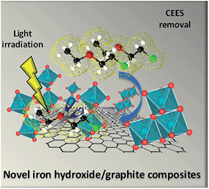Visible light enhanced removal of a sulfur mustard gas surrogate from a vapor phase on novel hydrous ferric oxide/graphite oxide composites†
Abstract
In this work, novel composites of iron hydroxide and graphite oxide (GO), initial or modified with urea, were synthesized and used as media for a 2-chloroethyl ethyl sulfide (CEES) removal/decontamination process. The results of surface characterization, using various physical and chemical methods, indicated that oxygen groups in GO act as nucleation centers for the hydrous ferric oxide formation/aggregation. Addition of the graphene phase increased the surface area and the amount of reactive adsorption centers. The iron hydroxide particles were highly dispersed between and on the graphene layers. Mesoporous 2 and 6-line ferrihydrites with a surface area higher than 200 m2 g−1 were identified as the main inorganic phase of the composites. An alteration in the optical band gap was found, depending on the chemical properties of the graphite oxide. The composites demonstrated a marked CEES adsorption capacity and outperformed the unmodified iron hydroxide. Visible light enhanced the removal of CEES owing to its photocatalytic properties. As a result of this, CEES degradation products migrate to very small pores of the composites, releasing the adsorption centers for further reactive adsorption of the CEES molecules.


 Please wait while we load your content...
Please wait while we load your content...